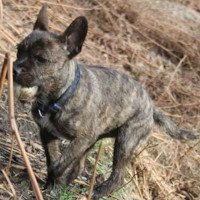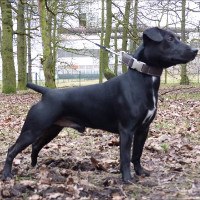Appearance of the Patton Terrier
|
| The Patton Terrier is a medium-sized dog, but even so, it's still quite small. Many describe the Patterdale Terrier as a miniature Labrador Retriever, and the Patton Terrier will also have many of the Labrador's physical traits. His body will be robust and muscular. His color is often brindle. Occasionally, he may have white markings, especially on his chest. He may also have a white blaze on his face. This is determined by the dominant parental breed. Often, he won't have the characteristic apple head of a Boston Terrier, his muzzle is longer and his ears may even be floppy. His coat may be smooth or broken, depending on the dominant parent breed. His hair will be short and stiff, resting close to his body. His tail will be a little long and may appear broken if he inherits the corkscrew tail of the parent Boston Terrier breed. |
Temperament of the Patton Terrier
|
| The Patton Terrier is a gentle, affectionate and energetic dog. He's good with children, but loves everyone in his family. He's certainly an excellent watchdog. He'll let you know whenever something doesn't seem quite right to him. However, he's actually very friendly with strangers, even after barking incessantly at a new person. He's very tough and can sometimes be stubborn. However, he is quite easy to train. Obedience classes are always a good idea. Your Patton Terrier strives to please you, and he may do better with a reward system rather than avoiding bad behavior for fear of punishment. He can sometimes be independent, and some owners warn that he doesn't get on well with non-dog pets such as cats, pet rabbits, etc. He may need to live in a house with a fenced-in yard to release some of his pent-up energy. |
Needs and activities of the Patton Terrier
|
| The Patton Terrier is a fairly active dog. In fact, it's advisable to give the Patton not only physical activity, but also mentally stimulating play. The Patton Terrier can be prone to mischief if left alone for long periods or if not properly exercised. He'll enjoy a trip to the dog park for a change of scenery. Keep in mind that the Patton has a brachycephalic parent breed, so your Patton may inherit the short muzzle of the Boston Terrier parent breed. The Patton should never be allowed to run free, as it is a hunter at heart and may be inclined to chase cars. One last thing to remember, the Patton is known to become inactive when kept indoors. He needs sufficient exercise to maintain his health. |
Maintenance of the Patton Terrier
|
| The Patton Terrier won't require much maintenance. It can have one of two coat types: smooth or broken. The smooth coat is coarse and dense. The broken coat is known as the intermediate coat, and will have slightly longer guard hairs than the smooth coat does. These hairs may be stiff and somewhat wavy. It may also appear to have a beard, mustache and eyebrows. Again, this depends on the dominant parent breed. Although the Patton Terrier is not likely to shed all year round, you can expect more shedding in spring and autumn. To avoid getting hair on your furniture and clothes, brush your Patton Terrier once a week with a wire brush. Bathe him only when necessary, as his natural oils will keep his coat shiny and healthy. Brush his teeth two or three times a week to prevent tartar build-up and bad breath. However, to prevent tooth decay, brush daily. Trim his nails every two weeks if they don't wear down on their own. As a general rule, if you hear his nails clicking on the floor, it's time to trim them. |









 English (United Kingdom)
English (United Kingdom)